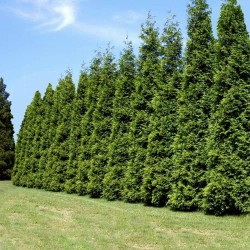
A növény ellenáll a hidegnek és a fagynak







Evergreen, Bonsai, Hedge Plant, Screen/Windbreak, Cold Tolerant... Thuja occidentalis, commonly known as American arborvitae or white cedar, is a dense, conical to narrow-pyramidal (sometimes maturing to broad-pyramidal), often single
Evergreen, Bonsai, Hedge Plant, Screen/Windbreak, Cold Tolerant...
Thuja occidentalis, commonly known as American arborvitae or white cedar, is a dense, conical to narrow-pyramidal (sometimes maturing to broad-pyramidal), often single-trunked, evergreen tree. It is often used for hedges, screens, and foundation plants. It needs full sun, likes high humidity but can be grown in virtually any soil. It doesn't mind pruning or high pH. This is a slow-growing tree that reaches 25-40' in height and spreads to about 10-12' wide. It is often found in the wild in low areas, wet forests and swamps and less frequently in some dryish sites. Mature trees may reach 40-60’ tall in the wild over time, but in cultivation typically grow much smaller to 20-30’ tall.
Scale-like, aromatic, yellow-green to dark green foliage appears in flattened sprays. Erect seed cones (1/2” long) are not particularly showy. Red-brown bark will exfoliate on mature branches and trunks. The common name of arborvitae (tree of life) comes from early French settlers to North America who learned from Native Americans that the tree’s foliage could be used to treat scurvy.
Common Names: Eastern Arborvitae, Northern White Cedar, White Cedar, American Arborvitae, Thuja obtusa, Thuja odorata,
Zone: 2 to 7
Growth rate: Slow
Plant Type: Needled evergreen conifer tree
Family: Cupressaceae
Native Range: Eastern North America
Height: 20 to 40 feet
Spread: 10 to 15 feet
Shape: Conical
Bloom Time: Spring
Bloom Color: Yellow
Flower/Fruit: Inconspicuous and not showy, 1/2" cones
Sun: Full sun to part shade
Fall Color: Evergreen, The foliage turns brownish in winter, especially if exposed to wind.
Drought tolerance: Moderate
Water: Medium
Maintenance: Low
Site Requirements /Soil Tolerances: clay; loam; sand; slightly alkaline; acidic; extended flooding; well-drained
Culture: Good in cold climates. Grow in average, medium moisture, well-drained soils in full sun to part shade. Somewhat wide range of soil tolerance, but prefers moist, neutral to alkaline, well-drained loams (especially of some limestone content). Intolerant of dry conditions. Best in full sun, but generally appreciates some light afternoon shade in hot summer areas. Avoid full shade. Avoid exposed, windy sites. Generally quite adaptable and tolerant once established.
Uses: Foundations and landscapes. Best used as a screen or hedge.
Adatlap